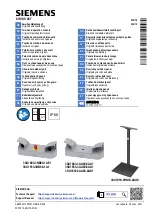
21
4 Controls
4.1
The Fat Channel
StudioLive™ 32.4.2AI
Owner’s Manual
Gate Threshold. Sets and Displays
the Threshold of the Gate for the
Selected Channel.
This encoder sets, and the meter
displays, the gate threshold for
the selected channel. The gate
threshold sets the level at which
the gate opens. Essentially, all
signals above the threshold
setting are passed through
unaffected, whereas signals below
the threshold setting are reduced
in level by the amount set by the
range control. If the threshold
is set fully counterclockwise,
the gate is turned off (always
open), allowing all signals to pass
through unaffected. You can set
the threshold from 0 to -84 dB.
Gate Range (32.4.2AI and
24.4.2AI only). Sets and Displays
the Range of the Gate.
This encoder sets, and the
meter displays, the amount
of gain reduction that the
gate will produce. The range
can be set from 0 to -84 dB.
Range control is not available
when using the expander.
Gate Attack (32.4.2AI and
24.4.2AI only). Sets and Displays
the Gate Attack Setting for the
Selected Channel.
This encoder sets, and the
meter displays, the rate at
which the gate opens on the
selected channel or output.
You can set the attack time
from 0.02 to 500 ms.
Power User Tip:
A fast attack
rate is crucial for percussive
instruments. Slow-rising signals
such as vocals and bass guitar
require a slower attack; with these
signals, a faster attack can cause
an audible click. All gates have the
ability to click when opening but a
properly set gate will never click.
Gate Release. Sets and Displays
the Rate at Which the Gate Closes
on the Selected Channel.
This encoder sets, and the meter
displays, the rate at which the
gate for the selected channel
closes. The release time can be
set from 0.05 to 2 seconds.
Power User Tip:
Gate-release
times should typically be set so
that the natural decay of the
instrument or vocal being gated is
not affected. Shorter release times
help to clean up the noise in a
signal but may cause “chattering“
with percussive instruments.
Longer release times usually
eliminate chattering and should
be set by listening carefully for the
most natural release of the signal.
Compressor On/Off. Turns the
Compressor On and Off for the
Selected Channel or Output Bus.
This button engages or
disengages the compressor
for the selected channel or
output bus. It will illuminate to
indicate that the compressor
has been enabled.
The compressor is available
for all 32/24/16 input channels
and every output bus.
Soft Knee Toggle Button.
Engages Soft-Knee Compression.
In normal operating mode, the
compressor is set for hard-knee
compression, meaning that the
gain reduction applied to the
signal occurs as soon as the
signal exceeds the level set by
the threshold. When the Soft
Knee button is engaged, the
onset of gain reduction occurs
gradually after the signal has
exceeded the threshold.
Auto Mode Button. Enables
Automatic Attack and Release
Mode.
When Auto mode is active, the
Attack and Release controls
become inoperative, and a
preprogrammed attack and
release curve is used. In this
mode, the attack is set to 10 ms,
and the release is set to 150 ms.
All other compressor parameters
can still be adjusted manually.
















































